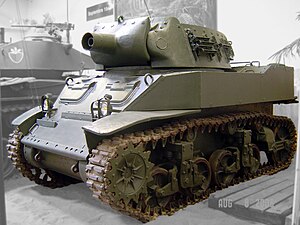M8 Howitzer Motor Carriage
| 75 mm Howitzer Motor Carriage M8 | |
|---|---|

75 mm Howitzer Motor Carriage M8 on display at the Musée des Blindés.
|
|
| Type | Self-propelled artillery |
| Place of origin | United States |
| Service history | |
| In service | 1942-1960s |
| Used by | See Users |
| Production history | |
| Designer | U.S. Army Ordnance Department |
| Designed | 1942 |
| Manufacturer | Cadillac division of General Motors |
| Produced | September 1942–January 1944 |
| No. built | 1,778 |
| Variants | See Variants |
| Specifications (75 mm Howitzer Motor Carriage M8) | |
| Weight | 34,600 lb (15.69 metric tons) combat weight |
| Length | 16 ft 4 in (4.98 m) with sand shields |
| Width | 7 ft 7.5 in (2.32 m) with sand shields |
| Height | 8 ft 11 in (2.72 m) over antiaircraft machine gun |
| Crew | 4 (Commander, gunner, driver, assistant driver/loader) |
|
|
|
| Armor | 0.375 to 1.75 in (9.5 to 44 mm) |
|
Main
armament |
75 mm Howitzer M2/M3 in Mount M7 46 rounds |
|
Secondary
armament |
.50 caliber (12.7 mm) Browning M2HB machine gun 400 rounds |
| Engine | Twin Cadillac Series 42 inline 6 cylinder 4-stroke gasoline engine 220 hp (164 kW) total at 3,400 rpm; 110 hp (82 kW) per engine |
| Power/weight | 14.02 hp/metric ton |
| Transmission |
Twin Hydramatic 4 speeds forward, 1 reverse |
| Suspension | Vertical volute spring suspension (VVSS) |
| Ground clearance | 14 in (0.35 m) |
| Fuel capacity | 89 US gallons (340 liters) |
|
Operational
range |
100 mi (160 km) on road |
| Speed | 36 mph (58 kph) on road |
|
Steering
system |
Controlled differential, steering levers |
The 75 mm Howitzer Motor Carriage M8 was a self-propelled howitzer vehicle of the United States developed during World War II.
The first design for a close support howitzer on an M5 tank chassis was the T41, which had the howitzer in the hull front. This did not progress past the mock-up stage as the crew would not have been sufficiently protected and design work started on the T47. It was developed on the chassis of the then-new Light Tank M5 (Stuart VI). The prototype was designated the 75 mm Howitzer Motor Carriage T17E1 It had the standard M5 turret removed and replaced with a larger open-topped turret; as a result, the drivers' hatches had to be moved from the hull roof to the glacis plate. After a mock-up had been produced, it was ordered into production as the 75 mm Howitzer Motor Carriage M8. The M8 was based upon the Light Tank M5, but incorporated several changes. Like the Light Tank M5, the M8 had a crew of four; commander, gunner, driver, and assistant driver/loader. When the M8 was in action, the commander positioned himself at the antiaircraft machine gun and directed his crew, the gunner sat in the turret on the right side of the howitzer, the assistant driver/loader moved up from his seat in the right front hull, and the driver stayed at his position.
Due to the usage of a new turret, the crew hatches in the hull roof for the driver and assistant driver/loader were deleted and replaced by a pair of vision flaps in the glacis. Since the glacis hatches were too small to disembark through, these two crew members had to leave the vehicle through the open-topped turret. The driver and assistant driver/loader were provided with periscopes for visibility. In November 1944, the Ordnance Department gave the M8 the name General Scott, after American general Winfield Scott.
As the M8 was based upon the Light Tank M5 (itself a descendant of the Light Tank M3) it had relatively thin armor. The lower hull armor ranged from 1 in (25 mm) to 1.125 in (28.6 mm) on the sides to 1.75 in (44 mm) on the lower front and 1.0 in (25 mm) on the lower rear. The lower hull sides were vertical, while the lower hull front was sloped at 18 degrees from the vertical, and the lower hull rear, which protected the engine and radiator, was sloped at 17 degrees from the vertical. The hull floor ranged from 0.5 in (13 mm) thick at the front to 0.375 in (9.5 mm) thick at the rear. The glacis plate of the M8 was sloped at 45 degrees from the vertical and was 1.125 in (28.6 mm) thick. The upper hull sides, like the lower hull sides, were vertical and 1.125 in (28.6 mm) thick at the front, thinning to 1 in (25 mm) thick at the rear. The upper rear hull was a vertical plate, 1 in (25 mm). The plate sloped at 50 degrees for a short distance before it met the hull roof, which was uniformly 0.5 in (13 mm) thick, and flat.
...
Wikipedia
